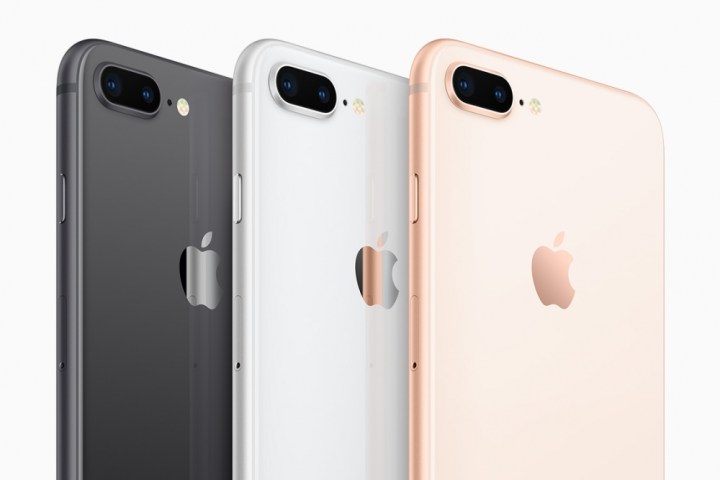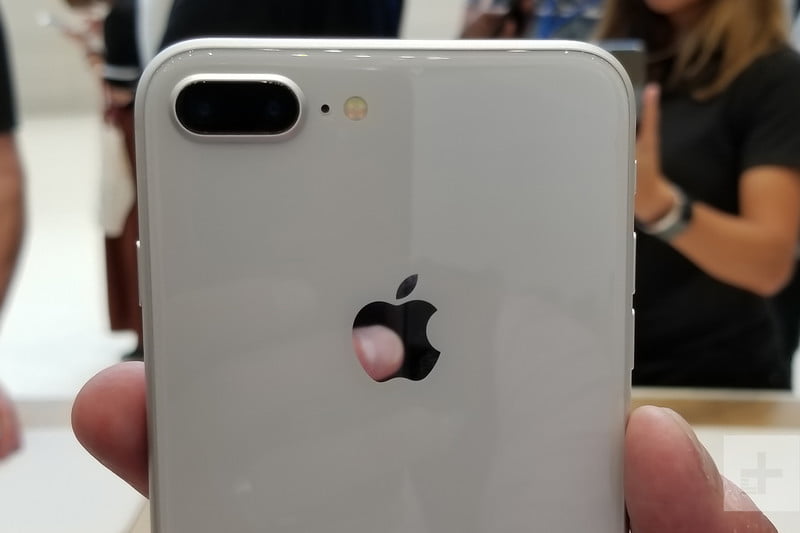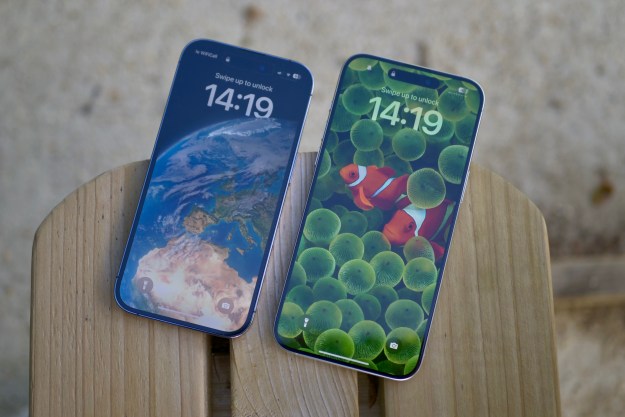
But the competition is formidable to say the least, and perhaps no phone measures up to the iPhone 8 Plus quite like the Galaxy S8 Plus. Samsung’s flagship boasts a speedy processor, a massive amount of memory, and a stunning edge-to-edge screen.
So how do the two smartphone titans compare? Read our iPhone 8 Plus vs. Galaxy S8 Plus guide for a blow-by-blow comparison of all the major features.
Specs
| Galaxy S8 Plus
|
iPhone 8 Plus
|
|
| Size | 6.28 × 2.89 × 0.32 inches (159.5 × 73.4 × 8.1 mm) | 6.24 x 3.07 x 0.30 inches (158.4 x 78.1 x 7.5 mm) |
| Weight | 173 grams (6.1 ounces) | 202 grams (7.13 ounces) |
| Screen | 6.2-inch Super AMOLED | 5.5-inch LCD IPS Retina HD |
| Resolution | 2,960 × 1,440 pixels (529 ppi) | 1,920 x 1,080 pixels (401 ppi) |
| OS | Android 7.0 Nougat | iOS 11 |
| Storage | 64GB (US), 128, 256GB (international) | 64, 256GB |
| MicroSD card slot | Yes | No |
| NFC support | Yes | Yes, Apple Pay only |
| Processor | Qualcomm Snapdragon 835, Samsung Exynos 8895 (international) | A11 Bionic with 64-bit architecture, M10 motion coprocessor |
| RAM | 4GB (U.S.), 6GB (select markets) | 3GB |
| Connectivity | GSM, CDMA, HSPA, EVDO, LTE, 802.11a/b/g/n/ac Wi-Fi | 4G LTE, GSM, CDMA, HSPA+, 802.11a/b/g/n/ac Wi-Fi |
| Camera | 12MP rear, 8MP front | Dual 12-megapixel rear, 7MP front |
| Video | Up to 4K at 30fps | Up to 4K at 60fps, 1080p at 240fps |
| Bluetooth | Yes, version 5 | Yes, version 5 |
| Fingerprint sensor | Yes | Touch ID |
| Other sensors | Accelerometer, gyroscope, barometer, compass, heart rate, proximity sensor, iris scanner | Barometer, 3-axis gyro, accelerometer, proximity sensor, ambient light sensor |
| Water resistant | Yes, IP68 rated | Yes, IP67 rated |
| Battery | 3,500mAh | 2,675mAh
|
| Ports | USB-C | Lightning |
| Marketplace | Google Play Store | App Store |
| Color offerings | Black, silver, gray, blue (international), gold (international) | Gold, silver, and space gray |
| Carriers | AT&T, Verizon, Sprint, T-Mobile | Verizon, AT&T, T-Mobile, Sprint |
| Price | $850 | $800 |
| DT review | 4 stars out of 5 | Hands-on review |
The iPhone 8 Plus and Galaxy S8 Plus both have powerful hardware. In fact, they’re pretty evenly matched.
The iPhone 8 Plus features the A11 Bionic system-on-chip, Apple’s cutting-edge processor designed specifically for the new iPhone. It consists of six cores total, two low-power cores that juggle high-intensity apps and four low-power cores to handle less demanding tasks, that work in tandem with a custom-designed three-core graphics chip.
Apple calls the A11 Bionic “the most powerful and smartest” ever in a smartphone, and it has the evidence to back it up. The A11’s high-performance cores and energy-efficient cores are 25 percent and 70 percent faster, respectively, than the A10 Fusion chip in the iPhone 7, and Apple’s GPU is up to 30 percent faster.
The Galaxy S8 Plus has Qualcomm’s octa-core Snapdragon 835 processor — the same chipset in the HTC U11, OnePlus 5, and LG V30. But more cores don’t necessarily equate to better performance. Early Geekbench 4 benchmarks show the A11 Bionic achieving a score of 4,188 in single-core performance and 10,069 in multi-core performance, or almost double the Galaxy S8 Plus’s best showing (1,832 single-core and 6,301 multi-core).
The Galaxy S8 Plus may have a leg up when it comes to memory, though. It packs 4GB of RAM, and while Apple doesn’t officially disclose specs like RAM and battery capacity, leaks suggest the iPhone 8 Plus has 3GB.
The differences between Android and iOS’s memory management make the real-world advantage tough to quantify.
The Galaxy S8 Plus should be theoretically capable of juggling more Chrome tabs, apps, and background tasks at once, but the differences between Android and iOS’s memory management make the real-world advantage tough to quantify.
Storage capacity is a different story. The Galaxy S8 Plus comes in 64GB and 256GB flavors, like the iPhone 8 Plus, but has a MicroSD card slot that supports up to 2TB of external storage.
Both the iPhone 8 Plus and the Galaxy S8 Plus have Bluetooth 5 onboard, which has four times the speed and twice the range of the iPhone 7’s Bluetooth 4.2, and both phones support near-field communication (NFC) for contactless payment at stores like Starbucks and Wallgreens. But the Galaxy S8 Plus also features magnetic secure transmission (MST), Samsung’s in-house payments technology that works with more 90 percent of point-of-sales terminals.
Overall, the iPhone 8 Plus has a clear advantage in terms of raw horsepower.
Winner: iPhone 8 Plus
Design, display, and durability

Judging by the specs, the iPhone 8 Plus and Galaxy S8 Plus shouldn’t feel all that different in the hand. The iPhone 8 Plus is a bit heavier at 202 grams, while the S8 Plus weighs 173 grams. They’re about the same height (6.24 inches versus 6.28 inches) and length (3.07 inches versus 2.89). But their designs are as different as their processors.
The Galaxy S8 Plus has a curved edge-to-edge screen that tapers off at either side and runs the length of the front, extending all the way to the space formerly reserved for a physical home button. There’s a generous amount of screen real estate, but the slippery glass sides can be tough to grip.
The all-glass back in the S8 Plus houses a single camera, flash, and fingerprint sensor. That’s all well and good for the most part, but the fingerprint scanner’s awkward placement next to the camera makes the lens pretty easy to smudge.
The iPhone 8 Plus, conversely, retains the look and feel of the iPhone 7 Plus. In fact, the two are nearly indistinguishable side by side. Thick bezels border all four sides of the flat screen, and Apple’s iconic Touch ID-enabled home button sits above the bottom chin.
The back is bare for the most part, save a glass cover that supports Qi wireless charging (more on that later). But the iPhone 8 Plus’s dual cameras stand out, and we’ll take a closer look at them in the camera section.
Both phones are durable, though the Galaxy S8 Plus is slightly more water resistant than the iPhone 8 Plus. It’s IP68 rated to withstand immersion in water up to five meters for 30 minutes, while the iPhone 8 Plus is IP67 rated for up to three feet of water for 30 minutes. The jury is out on their respective shatter and impact resistance, but it’s safe to say that neither the Galaxy S8 Plus nor the iPhone 8 Plus’s glass-and-aluminum shells will take much of a beating.
It’s safe to say that neither the S8 Plus nor the iPhone 8 Plus’s glass-and-aluminum shells will take much of a beating.
The matter is a little clearer when it comes to which phone has the better screen. The Galaxy S8 Plus’s 6.2-inch screen weighs in at a resolution of 2,960 x 1,440 pixels, which bests the iPhone 8 Plus’s 5.5-inch 1,920 x 1,080-pixel screen by a few hundred pixels. Even accounting for the size difference between the two, the Galaxy S8 Plus’s dense pixel arrangement (570 ppi versus the iPhone 8 Plus’s 401 ppi) should result in a much sharper image.
It’s also likely to be a more accurate one. The Galaxy S8 Plus’s screen uses Samsung’s Super AMOLED Plus technology to achieve superior brightness, contrast, black levels, and color accuracy. The iPhone 8 Plus’s Retina screen, on the other hand, is IPS LCD. It’s bright and color-accurate, and it has Apple’s True Tone, which automatically adjusts the screen’s color and intensity depending on ambient lighting conditions. But it can’t match the vibrancy of Samsung’s screen, and it doesn’t support high dynamic range (HDR) standards like HDR10 and Dolby Vision.
It’s a mixed bag when it comes to audio. Unlike the iPhone 8 Plus, the Galaxy S8 Plus has a 3.5mm headphone jack — on the 8 Plus, you have to make do with Lightning-to-3.5mm adapter or Bluetooth earbuds. But the iPhone has a new front-facing stereo speaker setup that’s 25-percent louder than the iPhone 7, which compares pretty favorably to the Galaxy S8 Plus’s single back-firing speaker.
Winner: Galaxy S8 Plus
Battery life and charging

The iPhone 8 Plus and Galaxy S8 Plus will easily get through a full day on a single charge. The Galaxy S8 Plus, though, might last a few hours longer.
Samsung pegs the Galaxy S8 Plus’s talk time at 24 hours, which is just enough to best the iPhone 8 Plus’s rated 21 hours of talk time. It lasts longer on Wi-Fi too — the Galaxy S8 Plus is estimated to last 15 hours on Wi-Fi compared to the iPhone 8 Plus’s 13 hours — and easily bests the iPhone 8 Plus when it comes to video playback. Samsung says the Galaxy S8 Plus can play movies, TV shows, and YouTube videos nonstop for 18, versus the iPhone 8 Plus’s 14 hours.
The Galaxy S8 Plus has less of an advantage when it comes to charging.
The Galaxy S8 Plus has a larger battery to thank. It packs a 3,500mAh battery, which is significantly bigger than the iPhone 8 Plus’s battery. (Apple doesn’t publish battery capacities, but documents on TENAA, China’s electronics regulating body, list the iPhone 8 Plus’s capacity as 2,675mAh.)
The Galaxy S8 Plus has less of an advantage when it comes to charging. Both the S8 Plus and the iPhone 8 Plus support rapid charging, albeit different standards: The Galaxy S8 Plus has Samsung’s Adaptive Fast Charging, which can fully recharge the phone in as little as an hour. Apple says its implementation of fast charging, meanwhile, can recharge the iPhone 50 percent in 30 minutes.
Both phones have wireless charging (a first for the iPhone), and both support the Qi wireless standard. (The Galaxy S8 Plus is also compatible with PMA charging pads and accessories.) The iPhone 8 Plus’s potential dark horse is AirPower, Apple’s tweak on Qi that allows for the charging of multiple devices at one time. But it won’t launch until 2018.
Winner: Galaxy S8 Plus
Cameras

The Galaxy S8 Plus and iPhone 8 Plus have excellent cameras, but there are some important differences.
The iPhone 8 Plus has two 12-megapixel cameras consisting of one wide-angle sensor with an f/1.8 aperture and a telephoto sensor with an f/2.8 aperture. Like the iPhone 7 Plus, the iPhone 8 Plus’s camera can optically zoom up to 4x and has a Quad-LED flash with Apple’s True Tone technology, which automatically adjusts the brightness to compensate for lighting conditions.
The Galaxy S8 Plus, on the other hand, has a single 12-megapixel camera paired with a dual-LED flash and an f/1.7 aperture.
Both the iPhone 8 Plus and Galaxy S8 Plus’s rear cameras are optically stabilized and can shoot in high dynamic range (HDR). And both can replicate the bokeh effect of DSLRs by blurring the background of an image while simultaneously sharpening the foreground.
But the iPhone 8 Plus has a feature that the Galaxy S8 Plus doesn’t: A Portrait Lighting mode that uses color and contour data from the iPhone 8 Plus’s dual rear sensors to relight a scene in real time. That’s in addition to improved pixel processing and color capture, faster autofocus, and noise reduction courtesy of the iPhone 8 Plus’s new image sensor.
The iPhone 8 Plus has a slight leg up on the Galaxy S8 Plus in terms of video, too. It can shoot in 4K at up to 60 fps (frames per second) and in 1080p (1,920 x 1,080 pixels) at 240 fps, while the Galaxy S8 Plus tops out at 4K at 30 fps and 1080p at 60 fps.
The phones’ front cameras are a bit more comparable. The Galaxy S8 Plus has an 8-megapixel front camera with a f/1.7 aperture and a wide-angle lens, and the iPhone 8 Plus has a 7-megapixel camera with a f/2.2 aperture.
One thing you won’t find on the iPhone 8 Plus’s front is the iPhone X’s sophisticated Face ID sensors. That puts it at a slight disadvantage compared to the S8 Plus, which has iris-scanning sensors on the front that can scan your eyes to lock the phone, log in to apps, and authenticate payments. But in fairness, the scanning process tends to be a little finicky.
Winner: iPhone 8 Plus
Software

The iPhone 8 Plus and Galaxy S8 Plus run very different operating systems.
The version of Apple’s mobile operating system that ships on the iPhone 8 Plus, iOS 11, is notable for a number of reasons. ARKit, a framework for augmented reality-driven experiences, benefits from the A11 Bionic chip. The CPU handles world tracking and keeps the graphics at a steady 60fps, while the iPhone 8 Plus’s dedicated signal processor adjusts for lighting conditions in real time.
There’s plenty new to explore in iOS 11 besides AR Kit. Siri sounds more natural, there’s a new screenshot tool that lets you mark up snapshots with a variety of different stylus styles and fonts, and you can use the iPhone’s keyboard one-handed. And that’s just scratching the surface.
The iPhone 8 Plus doesn’t really have a better operating system than the Galaxy S8 Plus, and vice versa
The Galaxy S8 Plus runs TouchWiz, Samsung’s custom-designed Android interface. Perhaps the highlight is Bixby, a Siri-like digital assistant serves up contextually relevant information, recognizes objects using the Galaxy S8 Plus’s camera, and responds to voice commands. TouchWiz also supports Dex Station, a docking station (sold separately) that transforms Galaxy S8 Plus into a fully functional desktop replacement.
The iPhone 8 Plus doesn’t really have a better operating system than the Galaxy S8 Plus, and vice versa. Unless you’ve already invested in one or the other or have devices that work better with, say, iOS than Android and TouchWiz, it comes down to personal preference.
Winner: Tie
Price and Availability
The iPhone 8 Plus is expensive, but it’s not quite as expensive as the Galaxy S8 Plus.
The iPhone 8 Plus costs $800 and comes in silver, gold, and space grey colors. It’s available for pre-order now, with availability beginning September 22.
The Galaxy S8 Plus, which launched earlier this year, is available from all major carriers, including AT&T, Sprint, T-Mobile, and Verizon. The 64GB model starts at $850.
| iPhone 8 Plus (64GB) | Galaxy S8 Plus (64GB) | |
| Verizon | $33.33 per month for 24 months ($800) | $35 for 24 months or ($840) |
| AT&T | $26.67 per month with AT&T Next, $33.34 per month for with AT&T Every Year ($800) | $35.42 for 24 months or $28.34 for 30 months ($850) |
| T-Mobile | $30 per month for 24 months with a $80 down payment ($800) | $130 down $30 for 24 months or $0 down and $33 for 24 months ($850) |
| Sprint | 33.34 per month for 24 months ($800) | $35.42 for 24 months ($850) |
Winner: iPhone 8 Plus
Overall winner: iPhone 8 Plus
The iPhone 8 Plus and Galaxy S8 Plus are two innovative, cutting-edge smartphones with high price tags, and comparing the two is a little like comparing apples and oranges. The Galaxy S8 Plus has a big, bright, and beautiful curved AMOLED screen and a long-lasting battery, plus bonuses like a headphone jack and expandable memory. But the iPhone 8 Plus has a much faster processor and a superior camera.
The S8 Plus is a great Samsung phone, but — short of the iPhone X — the iPhone 8 Plus is Apple’s best iPhone yet.
Editors' Recommendations
- iPhone 16: news, rumored price, release date, and more
- A surprise phone just beat the Galaxy S24 Ultra in a big way
- The most common iPhone 15 problems and how to solve them
- Does the iPhone 15 have an overheating problem? Here’s what we know
- Your iPhone just got a new iOS update, and you should download it right now




